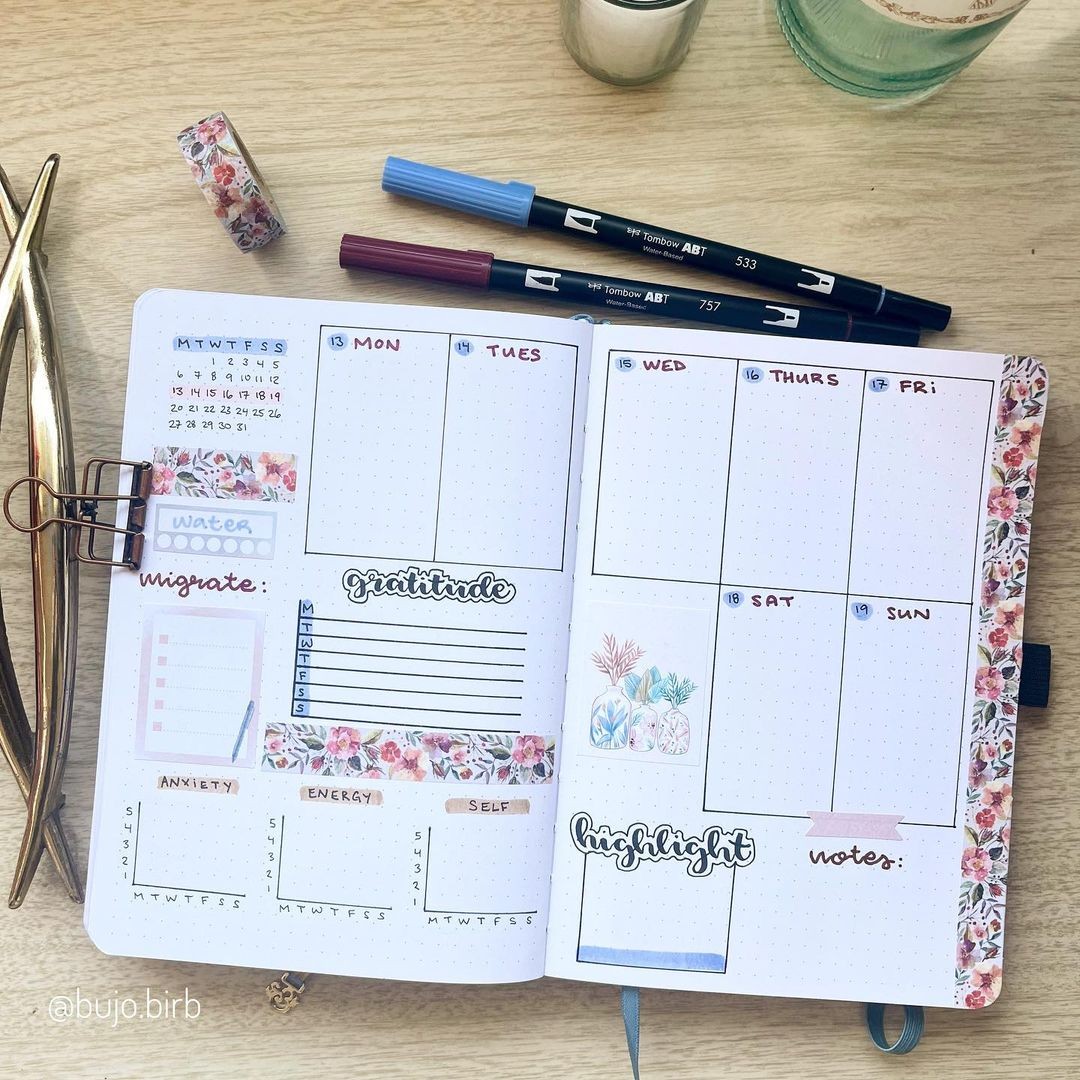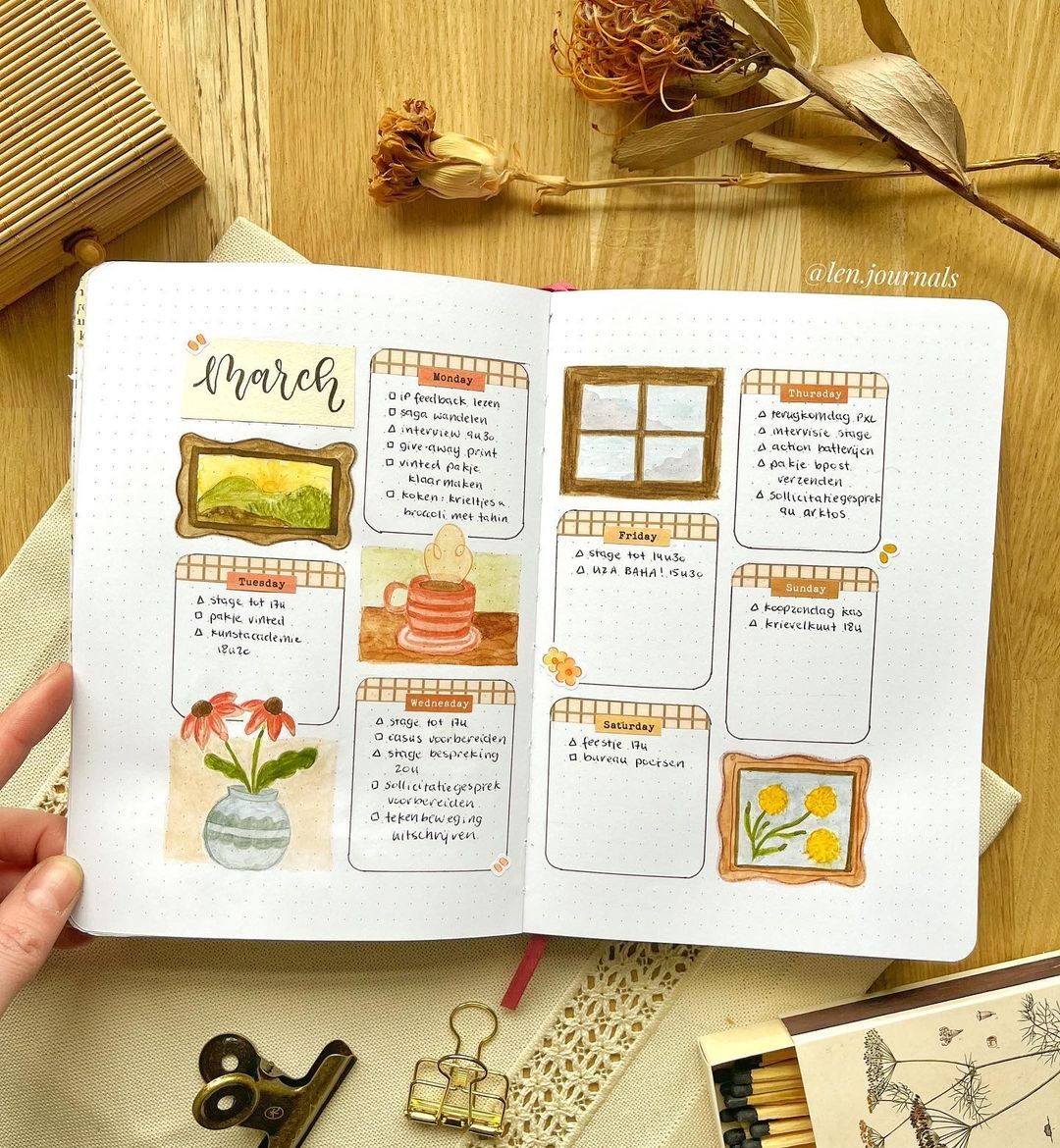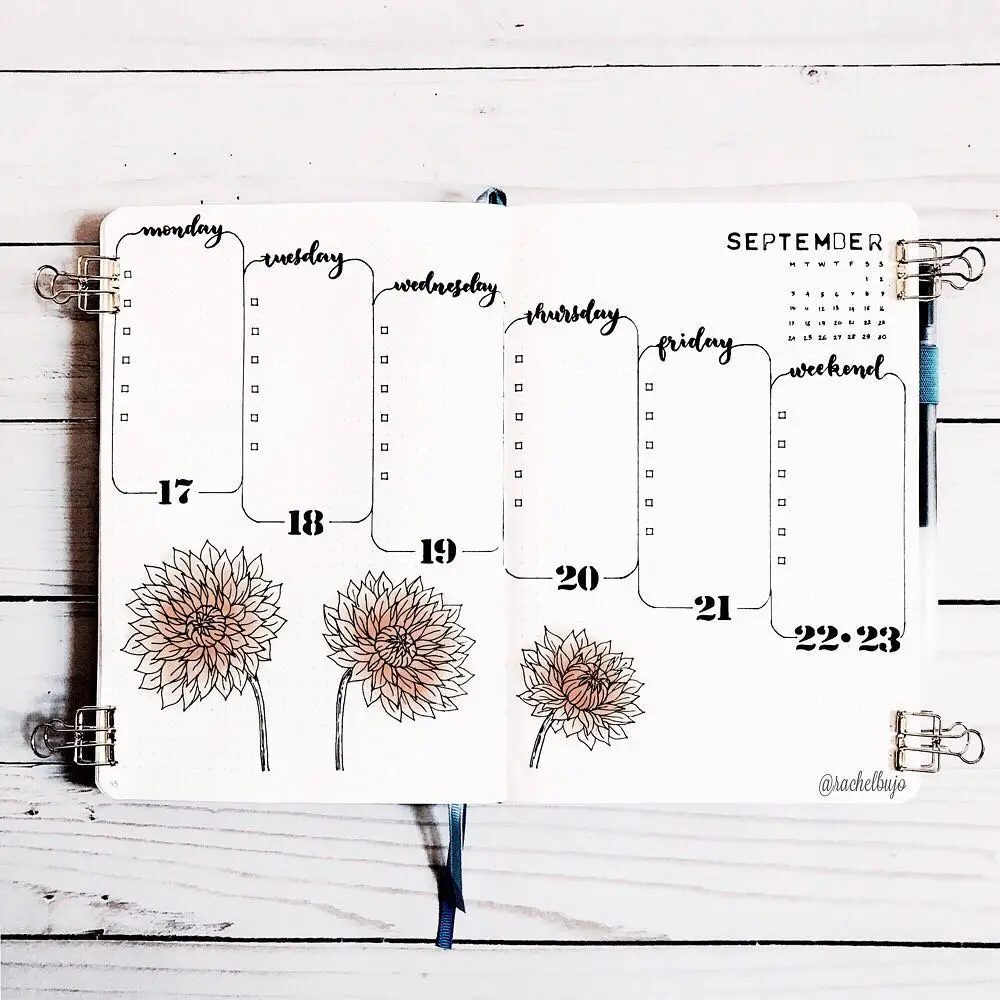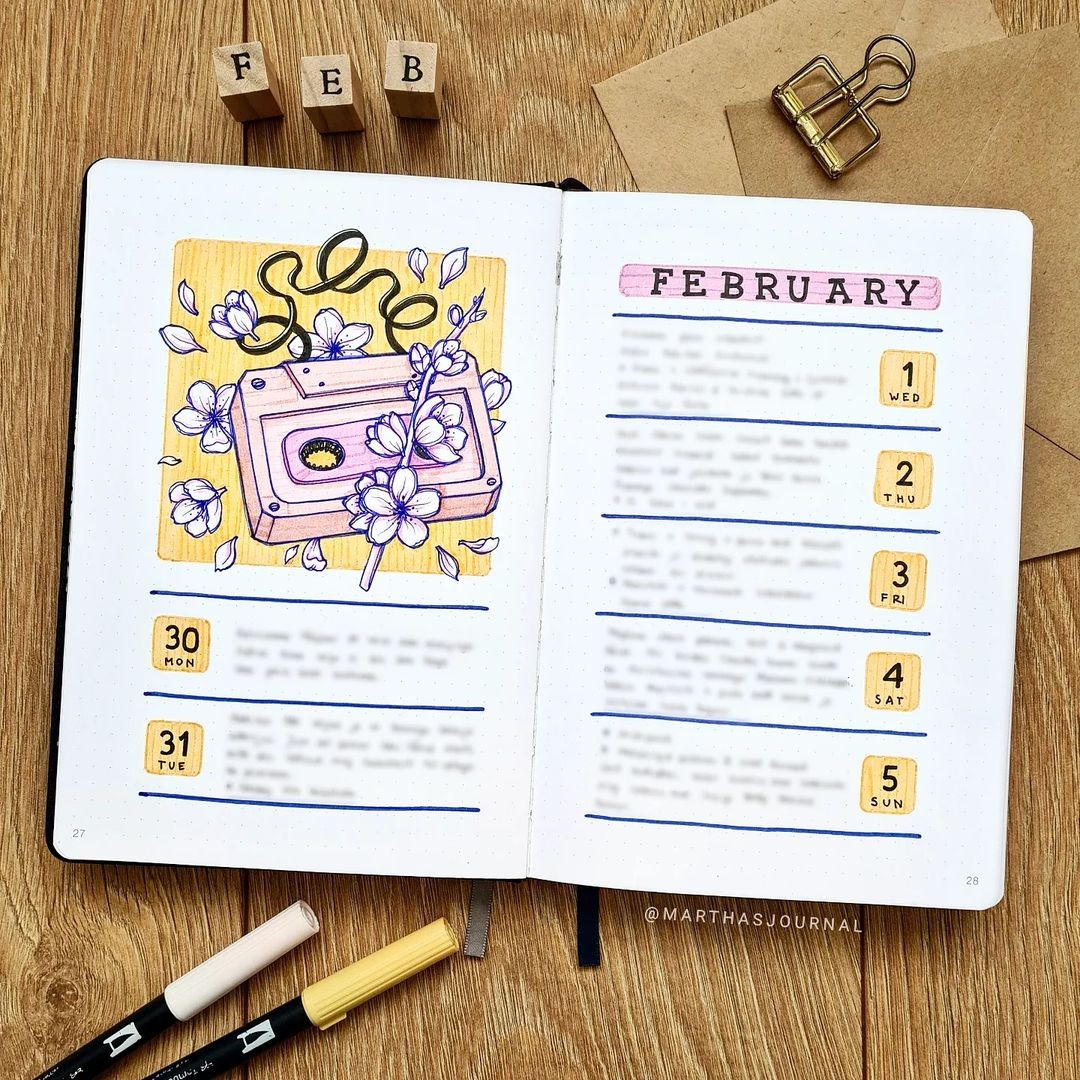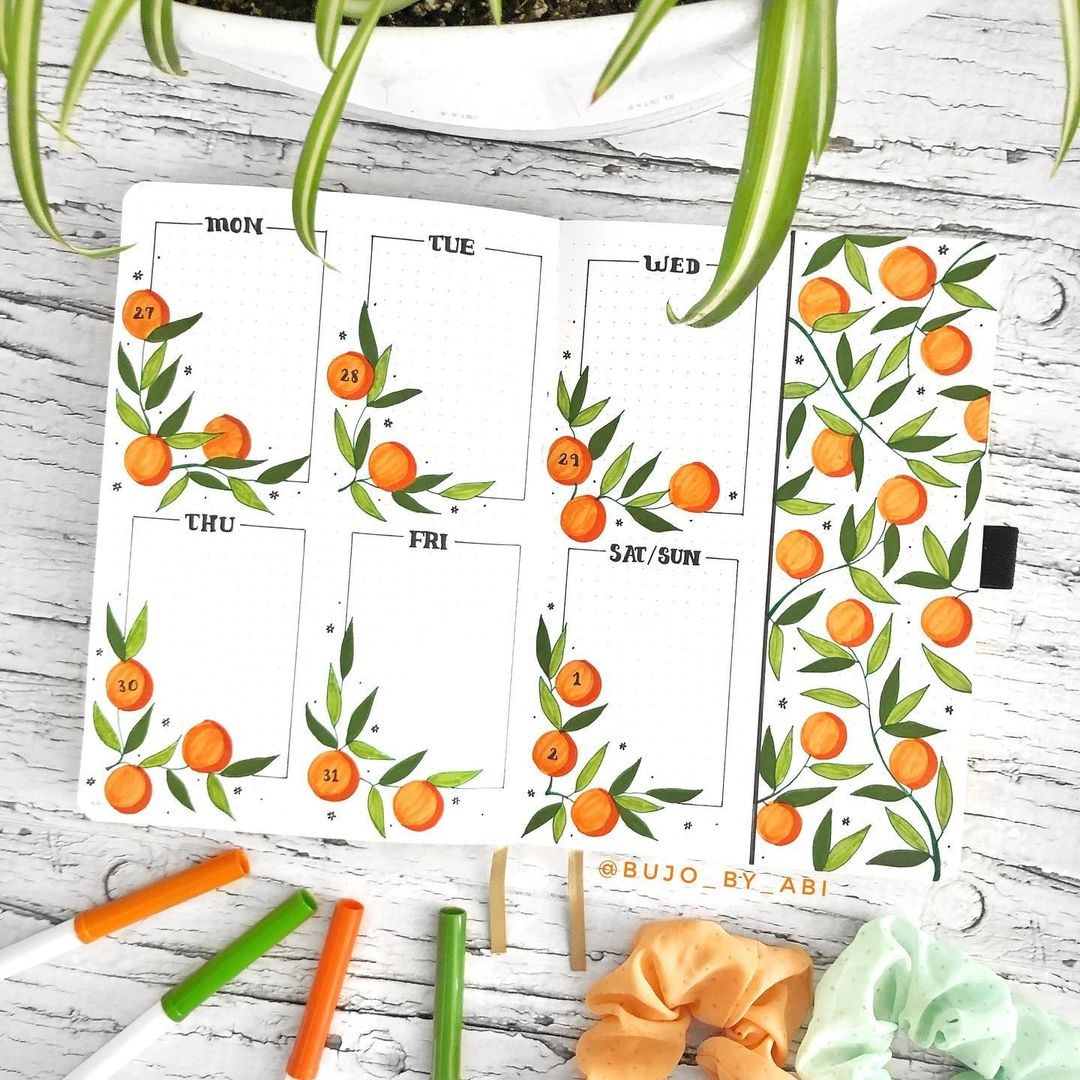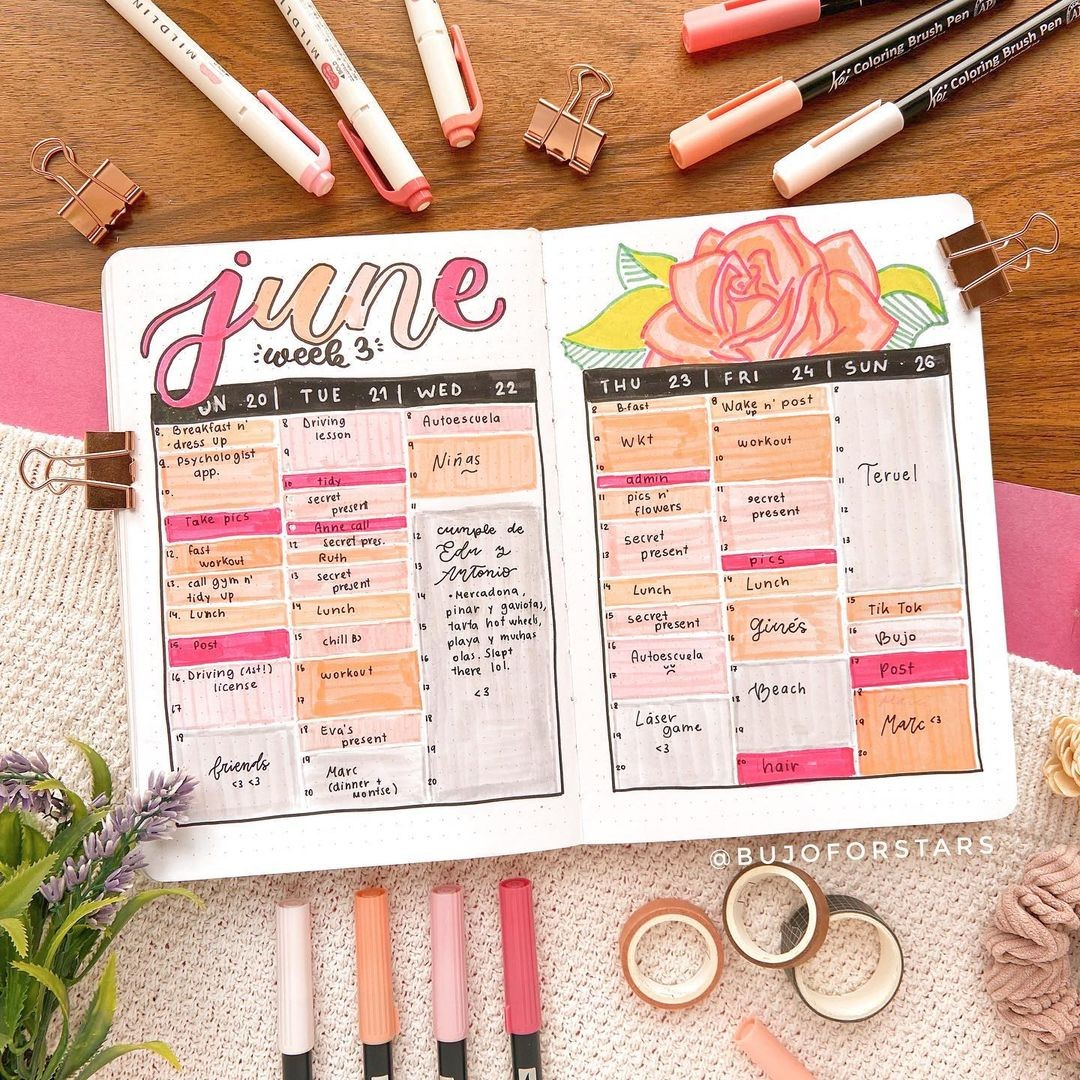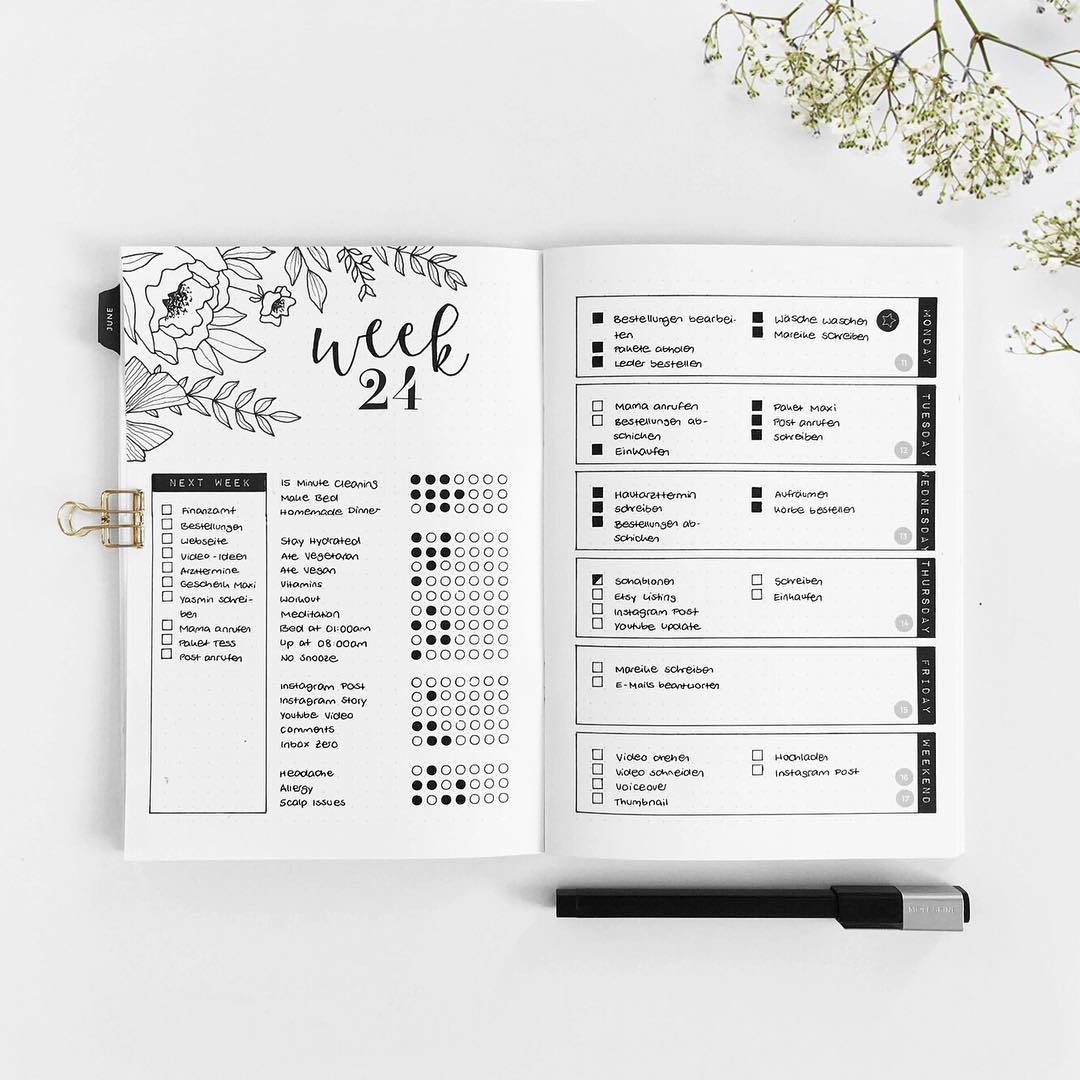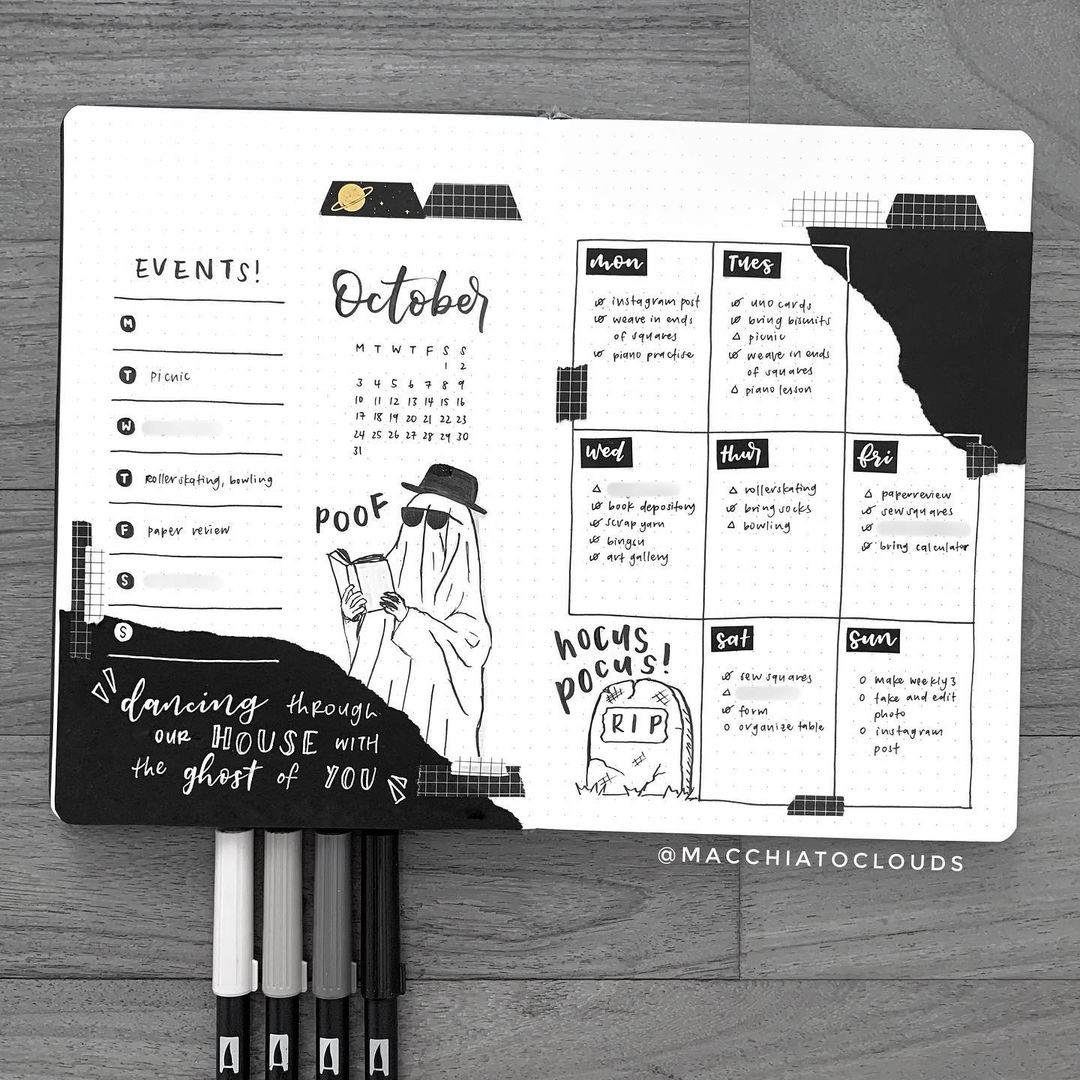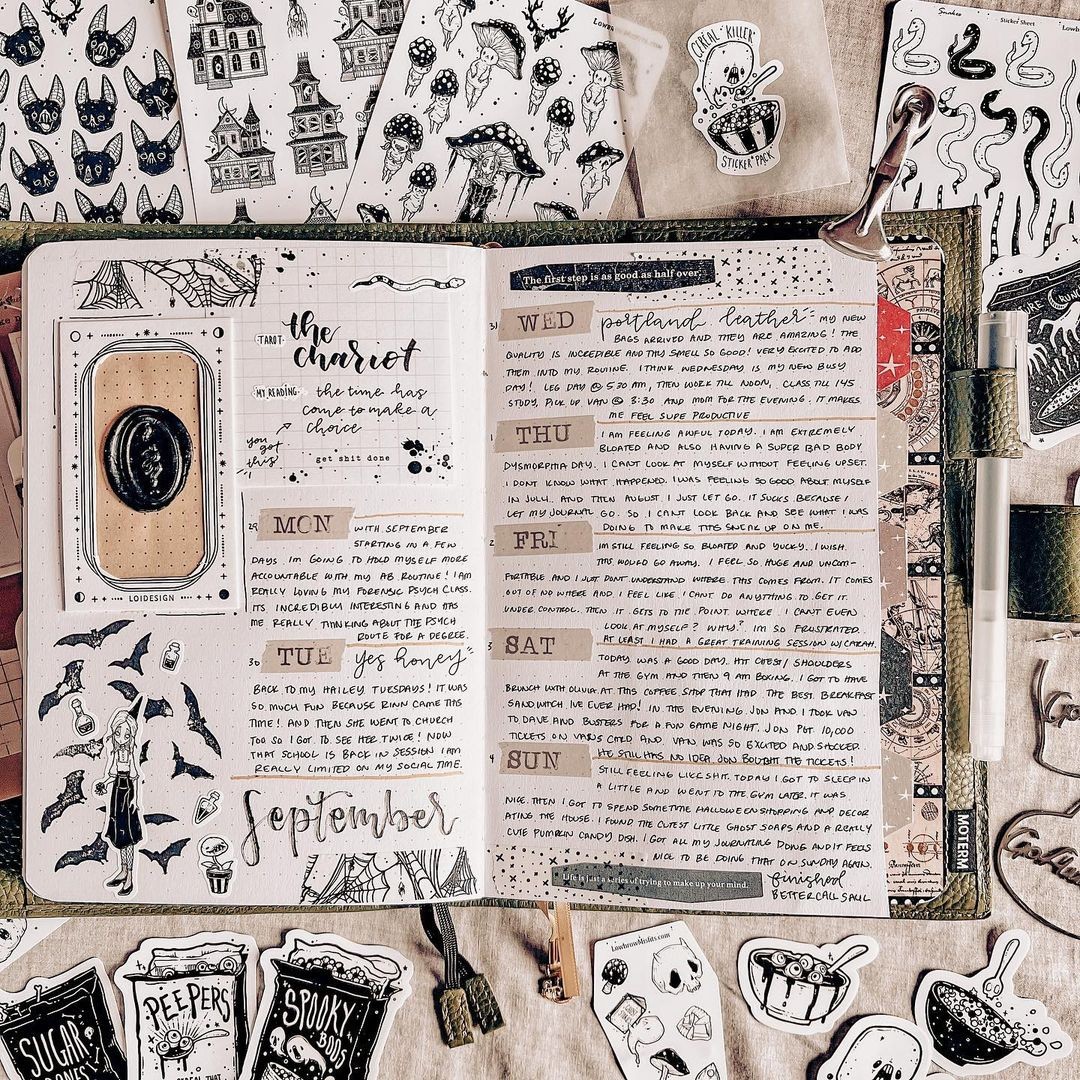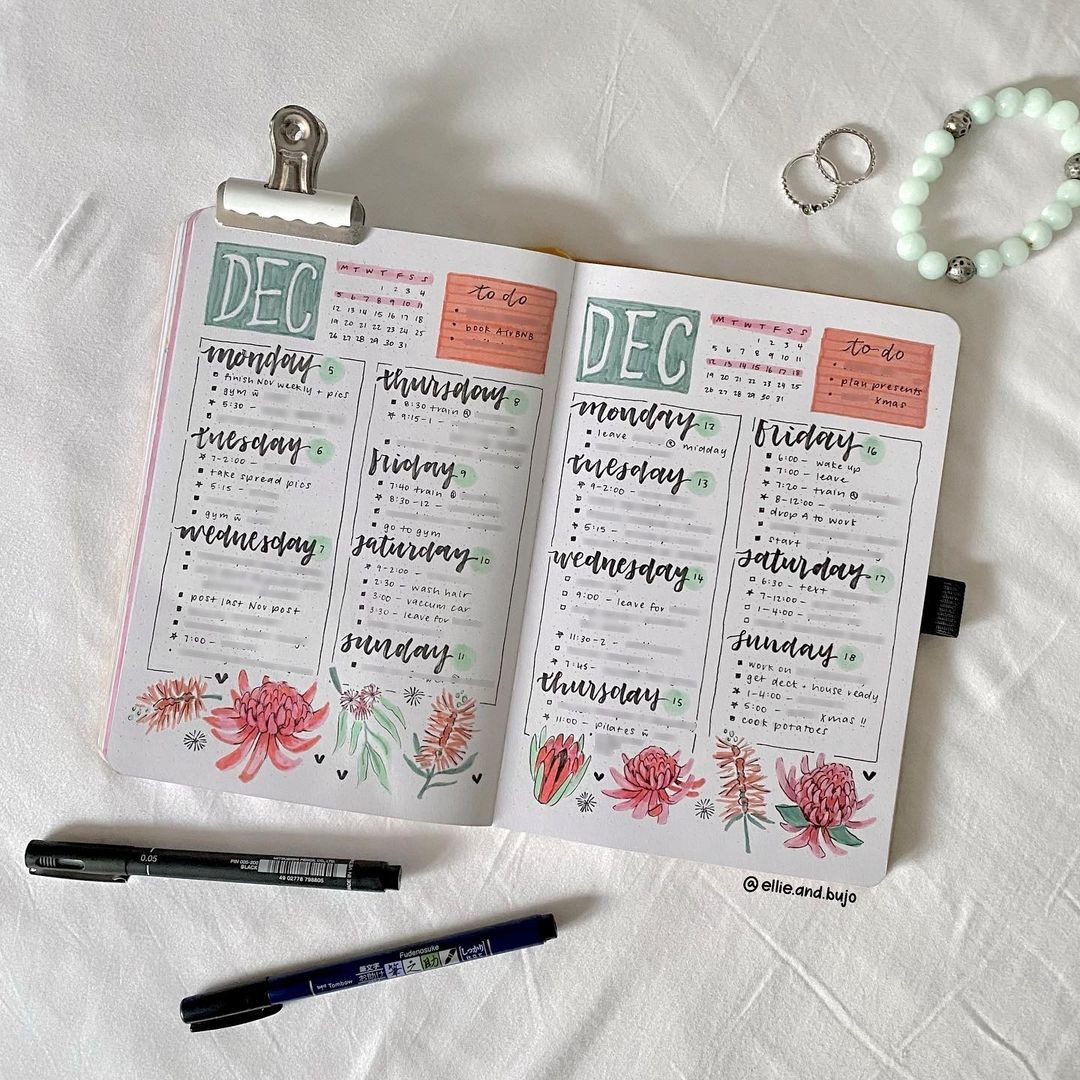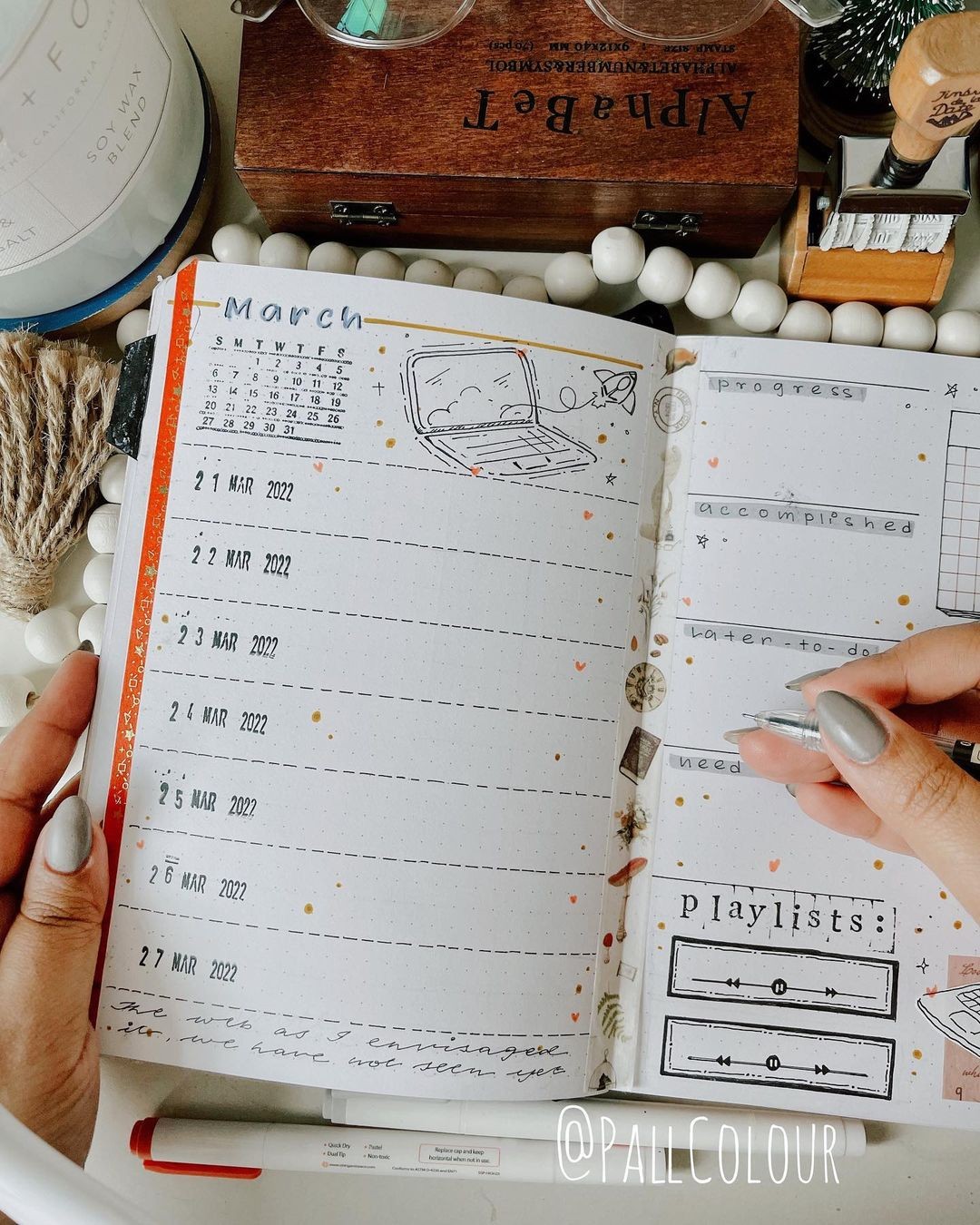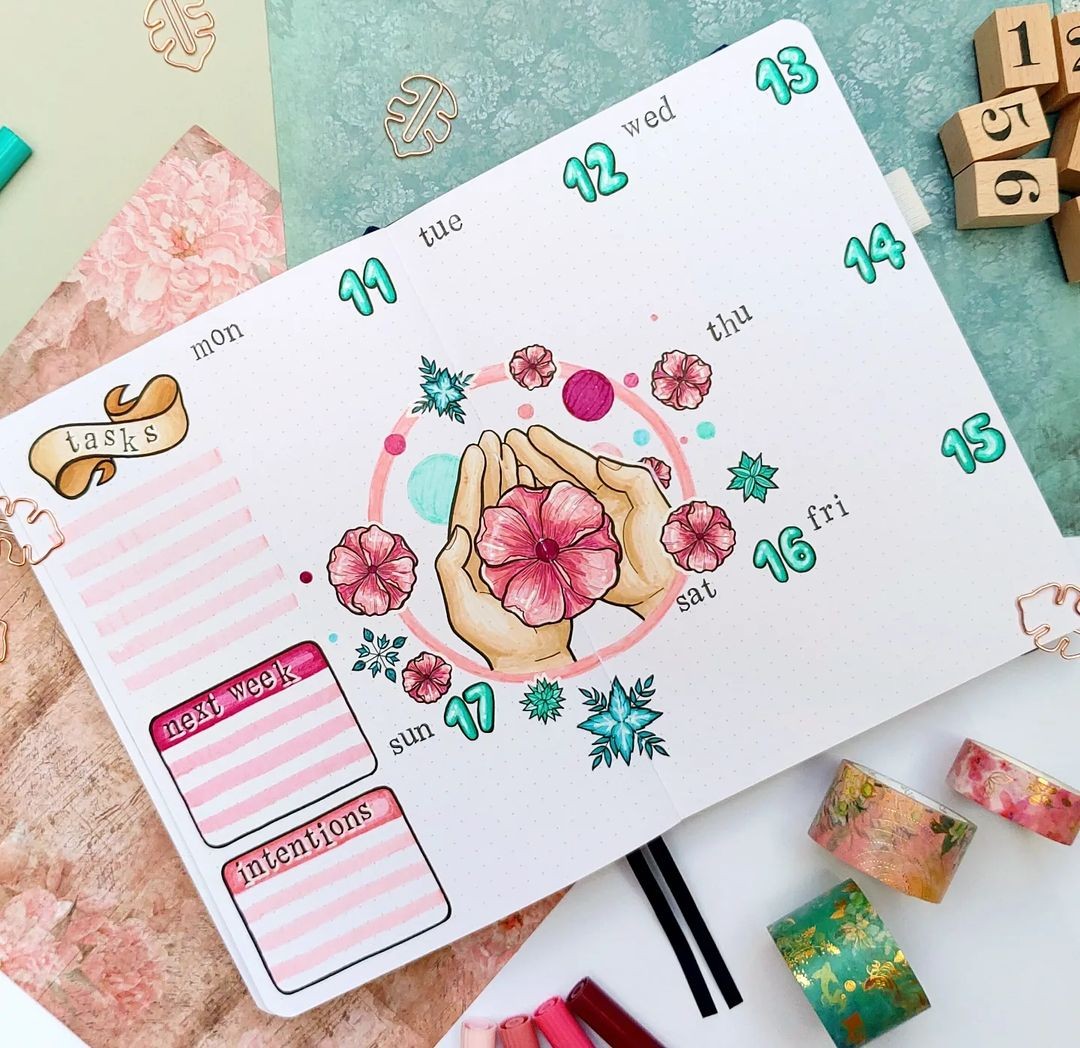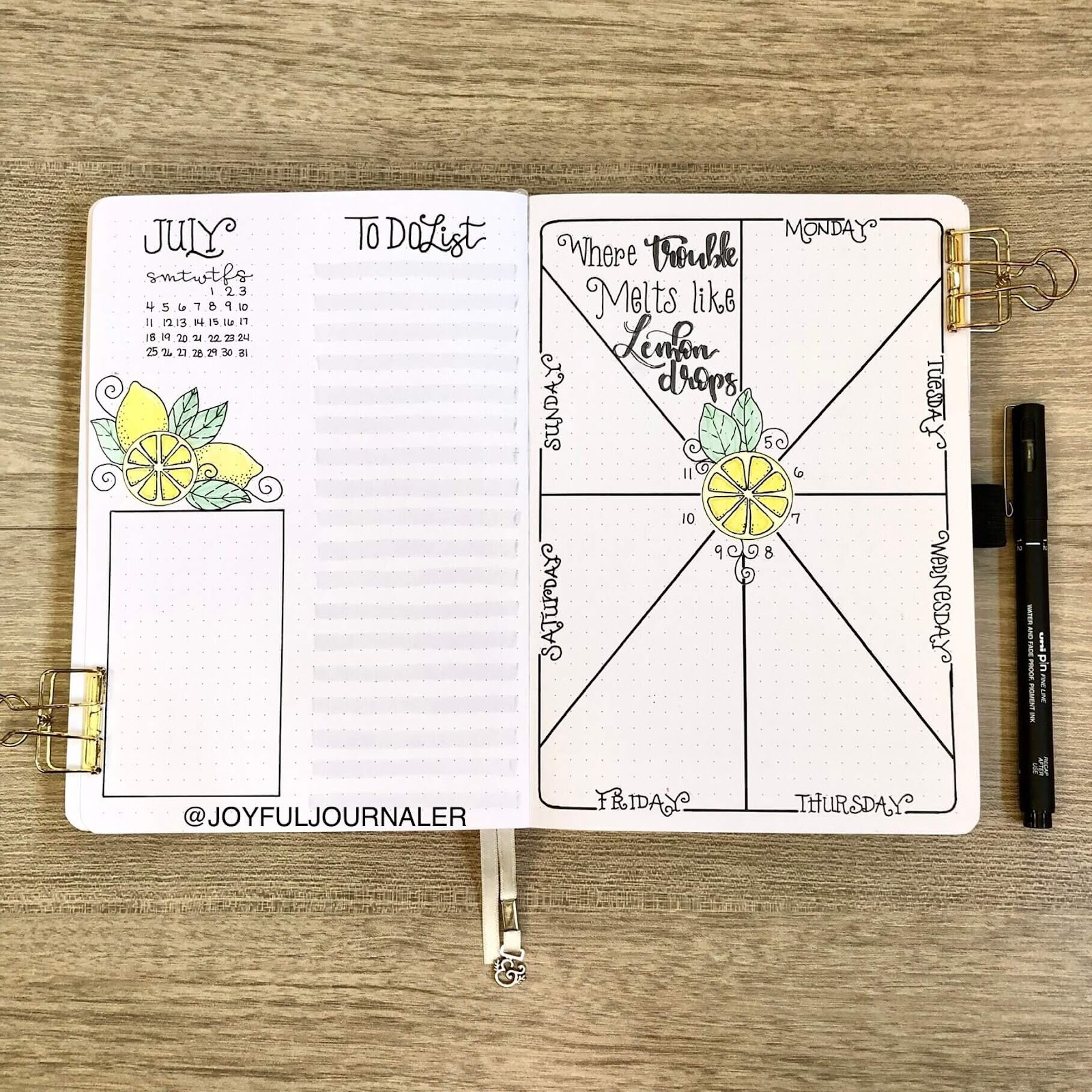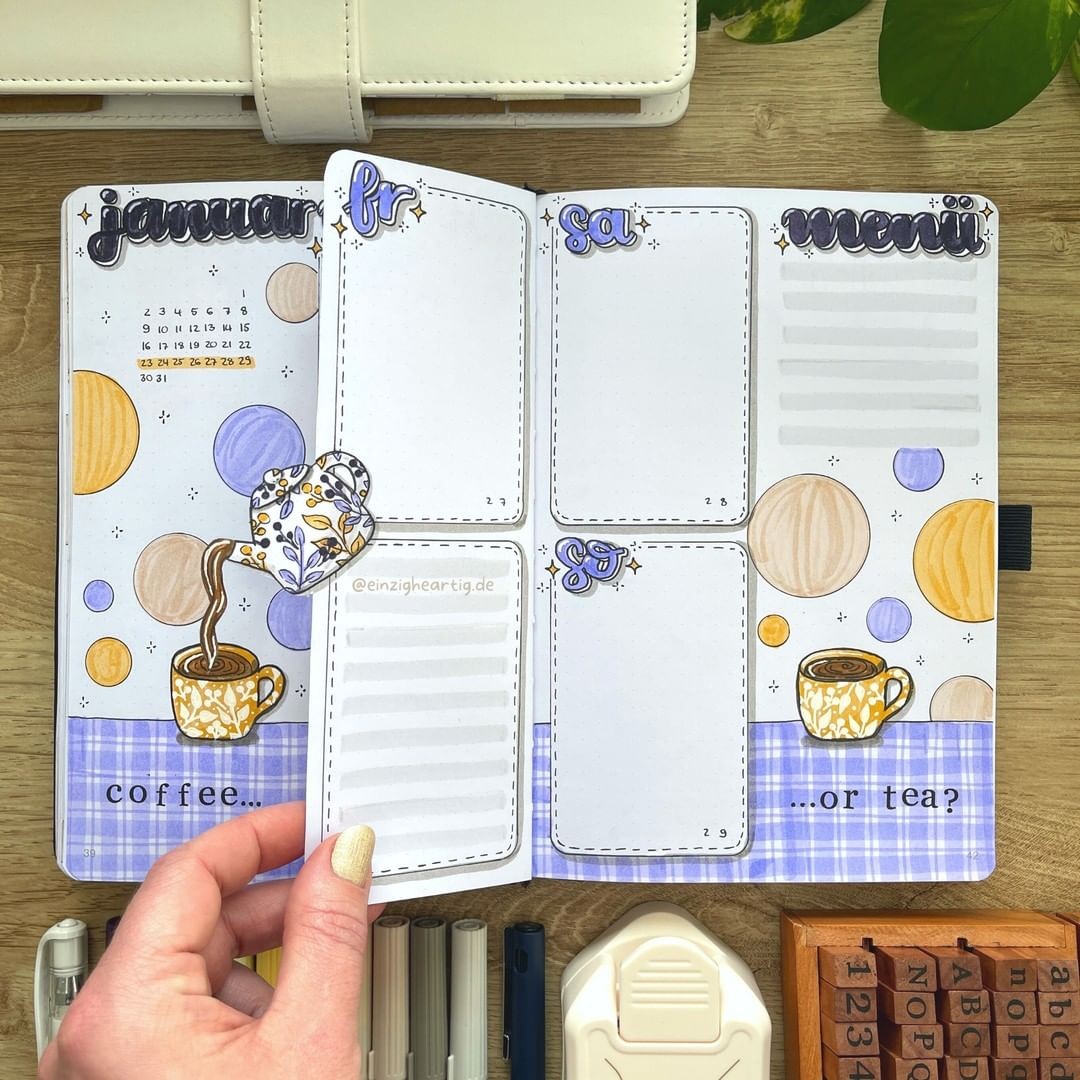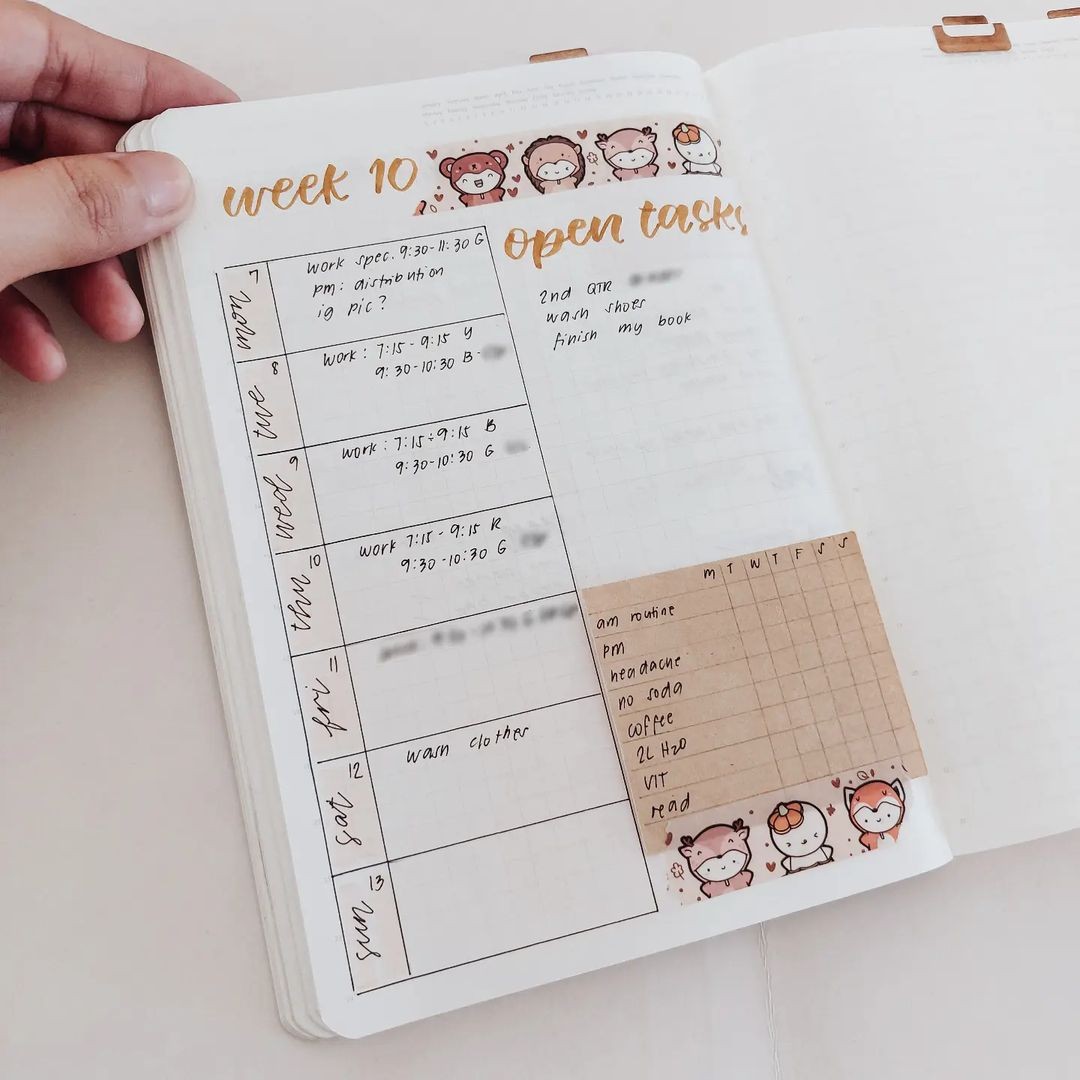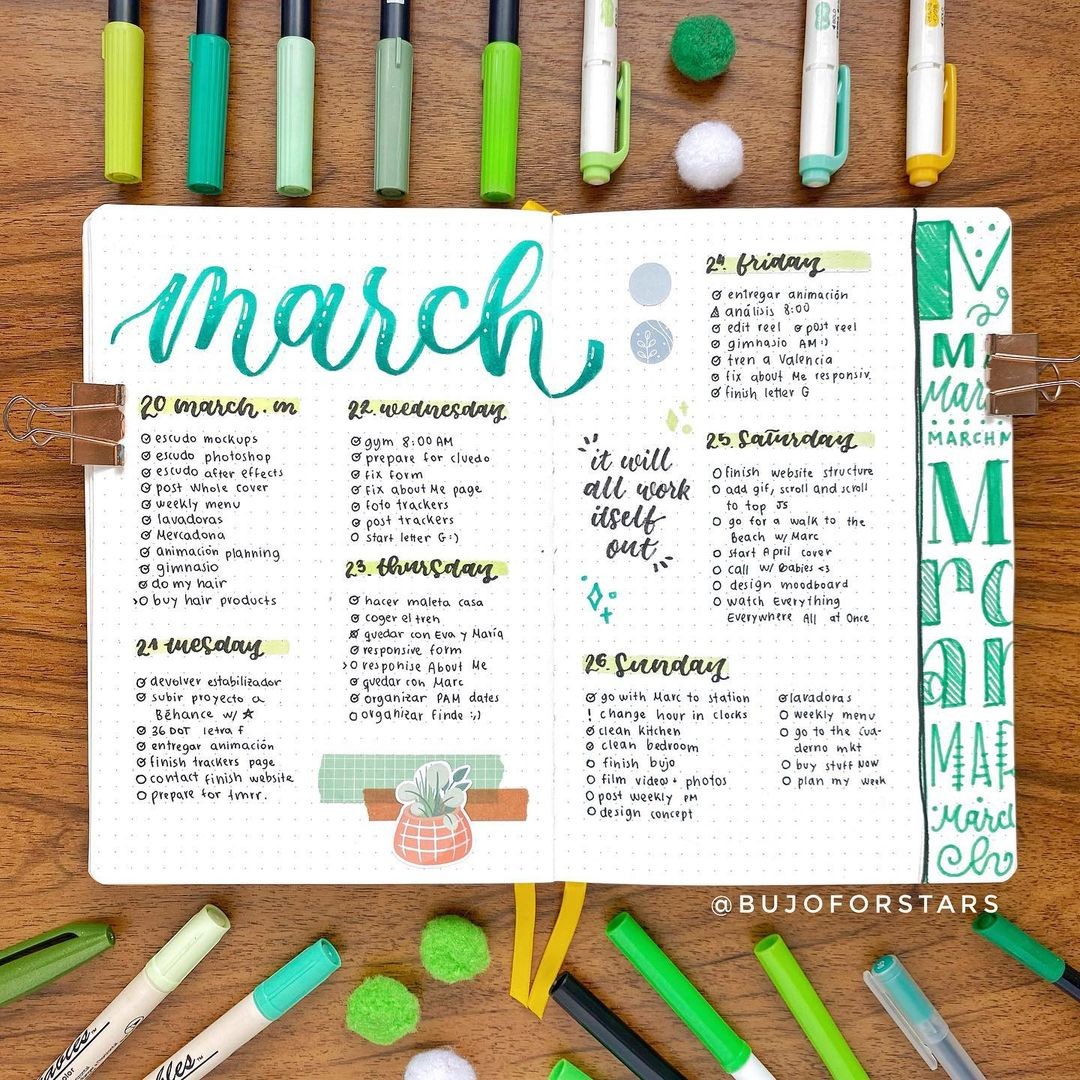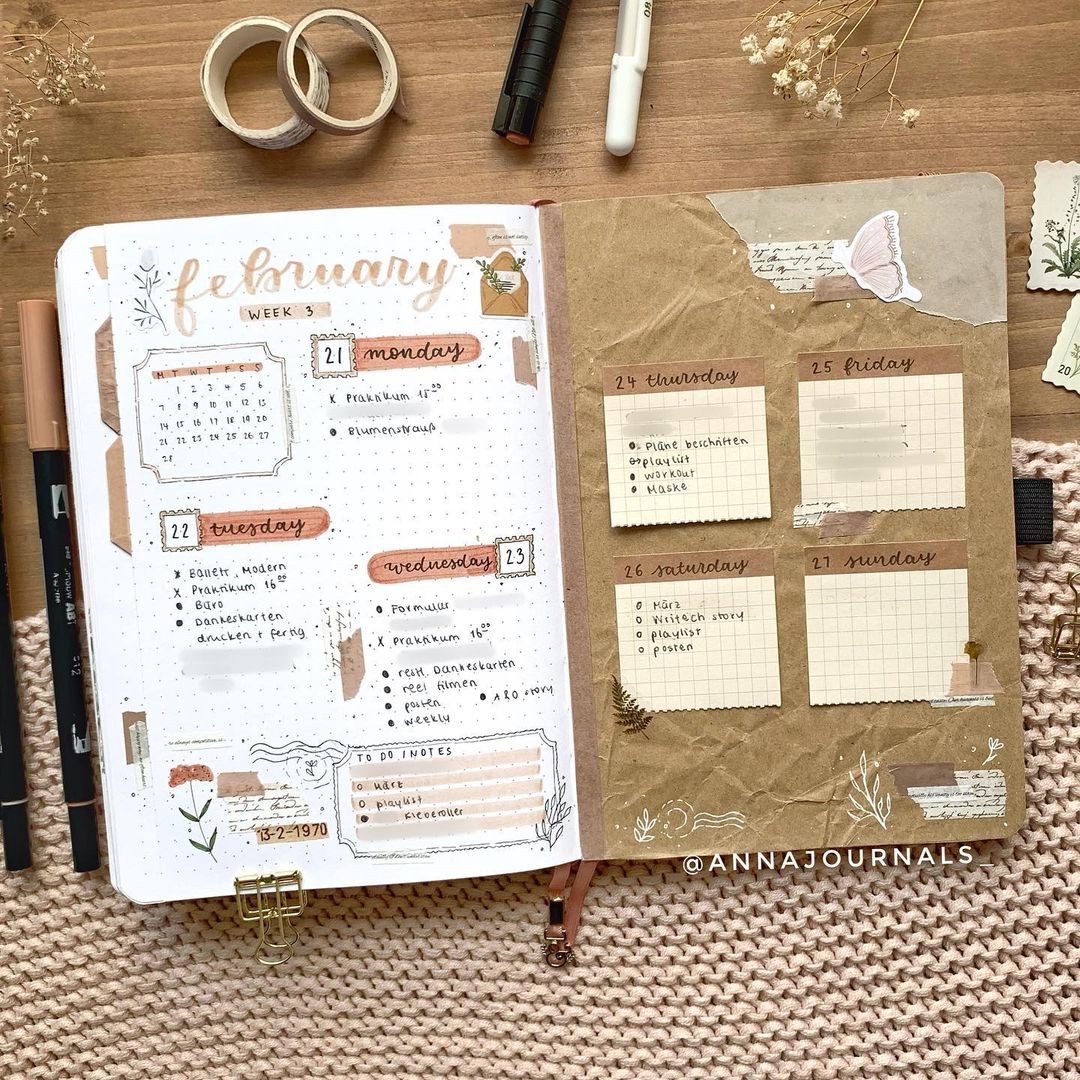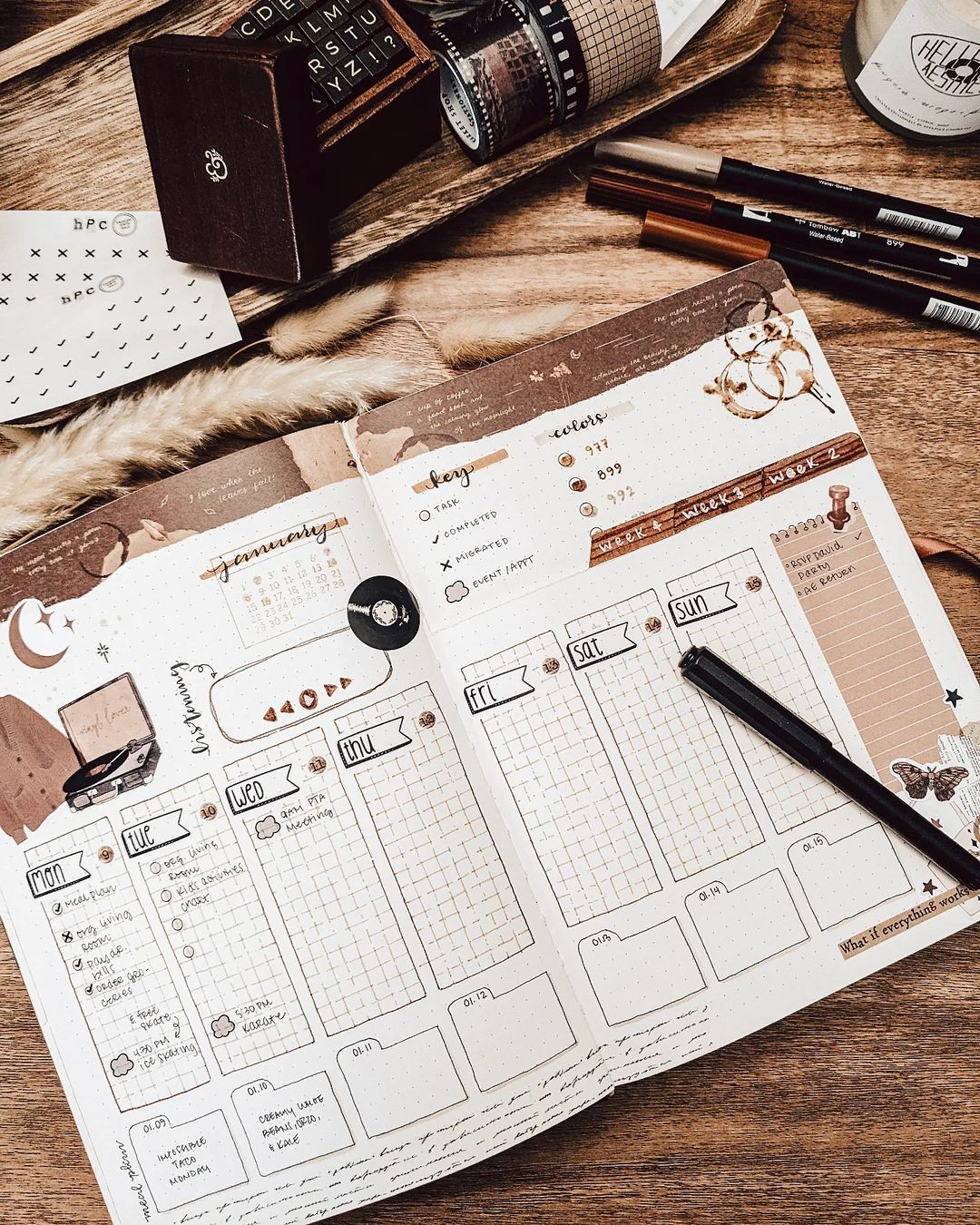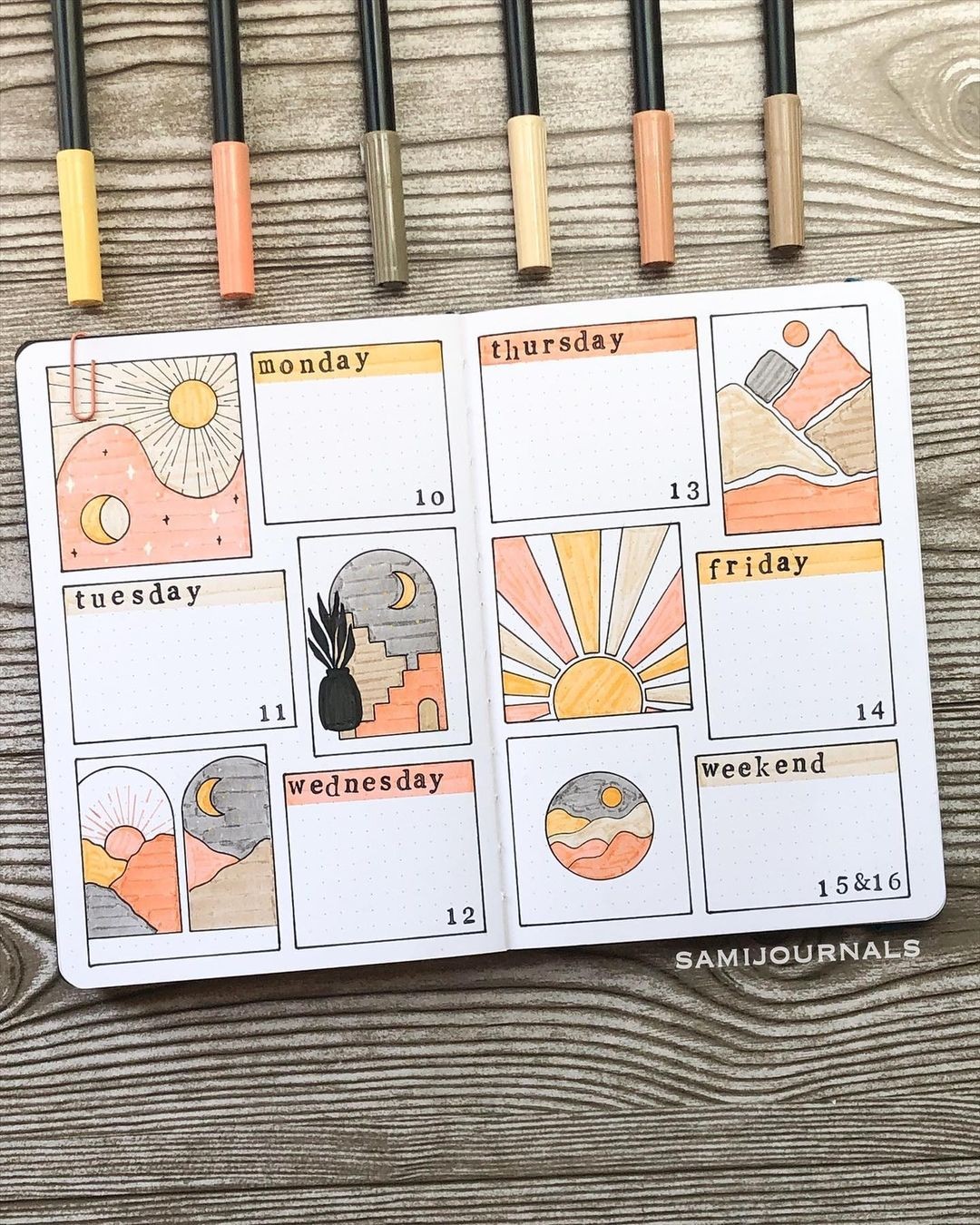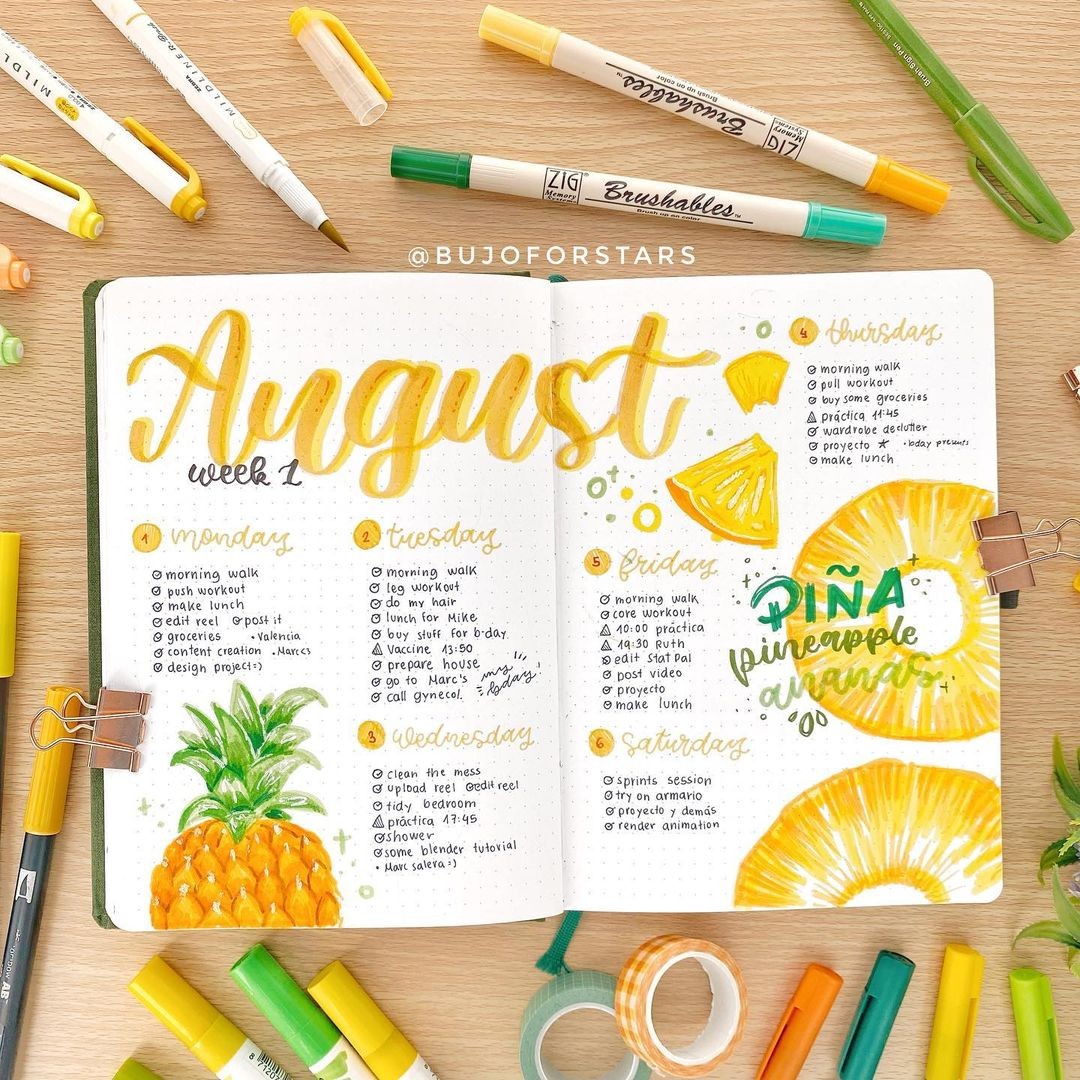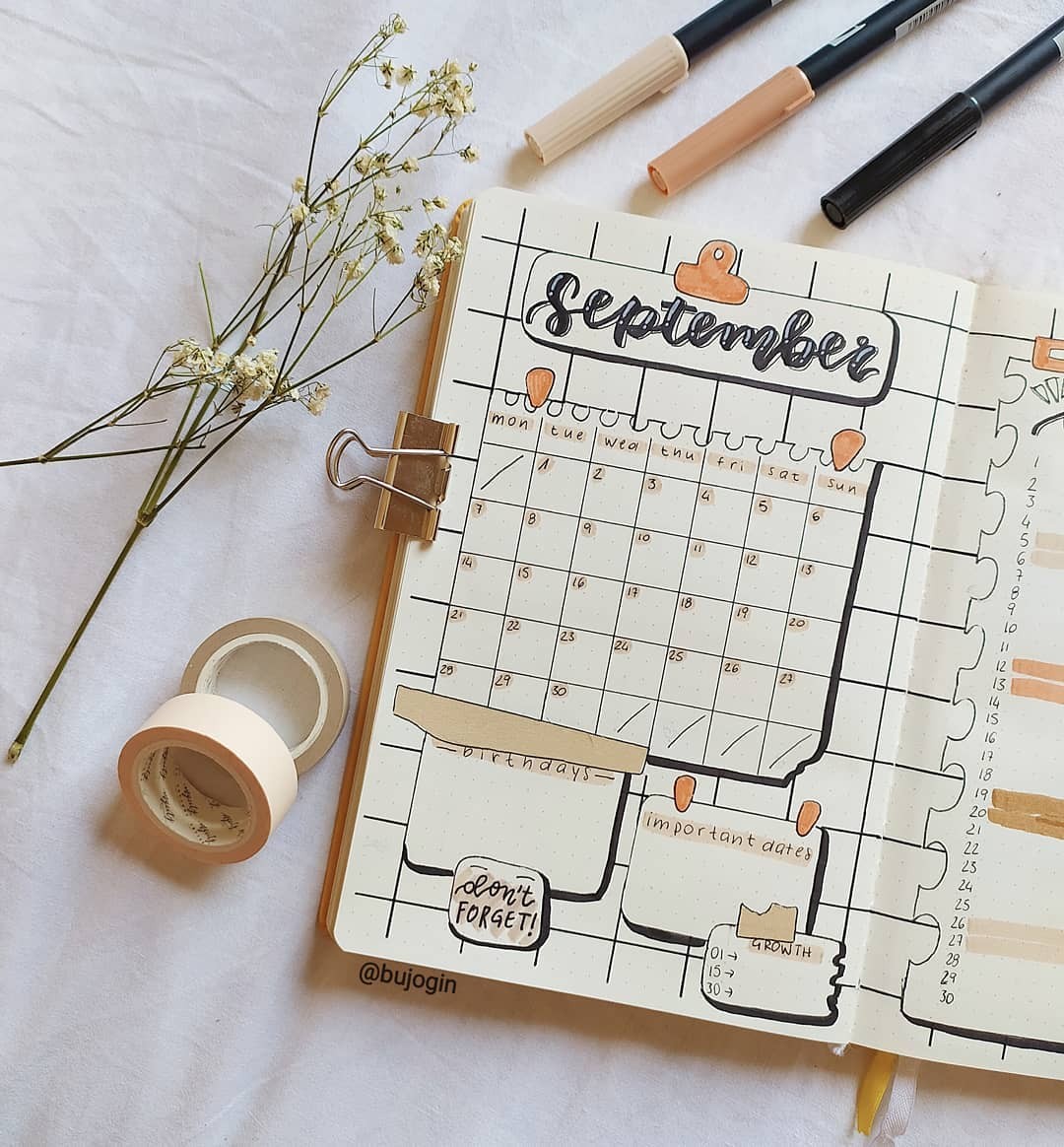What Is A Bullet Journal Weekly Spread?
image source
image source
image source
A bullet journal weekly spread is a visual planning tool that helps you organize your schedule and tasks for the week. This format, typically used in a notebook, utilizes a system of symbols or bullets to differentiate between various types of events, notes, and tasks.
The typical layout features seven days, starting from either Monday or Sunday, depending on personal preference. Each day is divided into sections or columns, which can be further subdivided for specific activities or appointments. Additionally, space is often reserved for note-taking or tracking habits/goals.
One of the unique aspects of a bullet journal weekly spread is its customization potential. Users can personalize their layout using colored pens and markers to create visually appealing designs or opt for simpler black-and-white or minimalist layouts, fitting individual needs and preferences. Overall, this system offers a flexible and adaptable framework for staying on top of tasks and goals.
Use Of Weekly Spreads In Bullet Journal & Its Top Benefits
In bullet journaling, creating personalized weekly spreads is a crucial aspect that serves multiple purposes. By setting up a weekly layout, individuals can effectively plan their week ahead, prioritize tasks and goals, and maintain focus throughout the week, ultimately leading to increased productivity and organization. This approach also enables better time management by breaking down daily tasks into manageable chunks, thereby reducing feelings of overwhelm and ensuring progress towards long-term objectives. Furthermore, weekly spreads provide a visual representation of one’s accomplishments, serving as a motivating factor that helps stay on track with goals. Additionally, the reflective aspect of these spreads allows individuals to cultivate a positive mindset, focus on the present moment, and identify areas for improvement in their routine or mentality. As a result, weekly spreads prove to be a potent tool for staying organized, focused, and motivated, ultimately fostering a sense of purpose and intentionality in one’s daily life.
10 Types Of Bullet Journal Weekly Spread
Whether you’re a seasoned bullet journalist or just starting out, having the right weekly spread can make all the difference in helping you stay organized and focused. And the good news is that there’s no one-size-fits-all approach – with so many different types of spreads to choose from, you’re sure to find one that suits your unique style and preferences. From simple and straightforward to elaborate and artistic, here are just a few examples of the many amazing weekly spreads out there:
Vertical Weekly Spread
One common calendar layout is a weekly planner that features days of the week arranged vertically, accompanied by ample space to jot down tasks or events for each day. This format has gained widespread popularity due to its ability to provide an overview of the entire week at a glance, making it easier to manage daily schedules and make informed decisions about time allocation.
Horizontal Weekly Layout
The first layout style featured in this section offers a straightforward and organized way to plan out your daily activities. A horizontal list of days, accompanied by ample space for jotting down tasks or events, provides a comfortable format for those who value having enough room to elaborate on each item. This design is particularly suitable for individuals who prioritize brevity and clarity in their daily planning.
Grid Bullet Journal Weekly Spread
The customizable grid layout in this planner offers the flexibility to tailor your daily organization to suit specific needs and goals. With separate spaces for tasks, events, notes, and habit tracking, you can create a unique structure that adapts to your unique requirements. The versatility of this design is attributed to bujo_by_abi.
Time Blocking Weekly Layout
The weekly setup in question employs a timeline format, permitting users to allocate precise time slots for tasks or events. This structure is particularly well-suited for individuals with numerous appointments or meetings to navigate throughout the week.
Minimalist Weekly Spread
In contrast, this minimalist layout offers a no-frills approach to task management, prioritizing simplicity and functionality over elaborate design. By stripping away unnecessary elements, it creates a clean slate for jotting down daily tasks, events, and habits – perfect for those who value efficiency over aesthetics. According to journalspiration, the beauty of this layout lies in its ease of creation and practicality, making it an excellent option for individuals seeking a hassle-free bullet journaling experience.
Holiday Weekly Spread
Creating a holiday-themed weekly spread is an excellent way to inject festive cheer into your planner or journal. With options for various holidays like Christmas, Thanksgiving, and Halloween, this type of spread can keep you organized while also putting you in the mood for celebration. To get started, select a color scheme or theme that aligns with the holiday you’re planning for. For instance, if it’s Christmas, red and green are classic choices, and adding gold or silver accents can give your spread a touch of luxury. Once you’ve chosen your palette, design your weekly spread by incorporating festive stickers, washi tape, or other embellishments. Consider including a motivational quote or message related to the holiday to keep the spirit of the season alive.
Journal Weekly Layout
For those who prefer to reflect on their daily experiences through written records, this weekly layout is an ideal tool. By dedicating space to record the highlights of your day and engage in daily reflections, you can cultivate a deeper understanding of your thoughts, feelings, and accomplishments. With this format’s flexibility, you’re free to adapt it to suit your unique needs. Perhaps one day you’ll use it to review a book you’ve read, while on another, it might serve as a space for a mental decluttering session. Whatever the purpose, this layout invites you to delve into the intricacies of your daily life and make the most of your journaling experience.
Single Page Week Layout
A single-page weekly layout is a condensed version of the classic bullet journal weekly spread, where all essential information for the week is neatly organized on one page. This simplified format has gained popularity among those seeking to minimize space in their journals or appreciate a more streamlined aesthetic. By consolidating crucial details onto a single sheet, users can effortlessly survey their schedule and commitments, facilitating effective time management and task prioritization.
Running List Bullet Journal Weekly Spread
A running list is a dynamic tool that allows you to continuously add and update items as they arise. This flexible layout enables you to track the status of various tasks or ideas, effortlessly moving completed items to the next page while keeping the remaining ones in view. By integrating this approach with your weekly log, you can effectively manage tasks without fixed deadlines. This method is particularly useful when you’re dealing with open-ended projects or daily errands that don’t have a specific due date.
Circular Weekly Layout
In contrast to traditional weekly layouts, the bullet journal circular layout presents seven distinct sections, each corresponding to a day of the week in a clockwise pattern. This novel approach offers a refreshing departure from the norm, allowing for creative expression and flexibility. Additionally, space can be allocated for important sections such as weekly tasks, notes for the upcoming week, and intention setting, ensuring a comprehensive planning experience.
Dutch Door Weekly Spread
When looking to accommodate daily tasks and reflections in a larger format, a Dutch door weekly spread proves an ideal solution. This layout involves dividing a half-page vertically, allowing for the creation of a two-sided journaling space that offers ample room for note-taking and personal reflection.
Simple Half Spread Weekly Layout
A half-spread weekly layout offers a straightforward approach to planning, allowing you to concentrate on the most critical tasks and events without getting overwhelmed by excessive details. This format is particularly beneficial for those with limited experience in planner or bullet journal layouts, or those struggling to find time. The simplicity of this design makes it an excellent starting point.To create this layout, begin by dividing your page vertically into two equal sections. On the left side, record the days of the week along with their corresponding dates. You can also add a small header or title to give this area visual appeal. This section will serve as a space for daily task lists, one for each day.On the opposite half of the page, allocate room for appointments, important events, or your weekly habit tracker. Consider using a bullet-point system or simple checkboxes to mark tasks as you complete them.
Freeform Weekly Layout
In contrast, a freeform weekly bullet journal layout offers a refreshing blend of creativity and spontaneity in your planning. This flexible format allows you to bring your personality and unique perspective to the page, while still maintaining the organization and structure needed for effective task management. As you work through your week, you can seamlessly integrate new tasks or events that arise, and even use this layout as a visual tracker for your progress towards specific goals or projects, leveraging symbols or markers to highlight what’s been accomplished.
Creative Weekly Spread
Weekly creative spreads combine the art of scrapbooking with personal expression, featuring a medley of materials such as patterned papers, stickers, washi tape, and photographs. The result is a unique and visually striking layout that reflects one’s personality. To create this type of spread, one can collate diverse patterned papers, fill empty spaces with creative doodles, add functional stickers to mark significant events or tasks, incorporate printed quotes for added context, and utilize washi tape to establish borders, dividers, or other visual interest points.
Themed Weekly Spread
When crafting a themed weekly spread, start by selecting a theme that resonates with you. This could be anything from a beloved book or movie to a specific color palette or seasonal motif. For instance, if your theme is ‘solar and lunar cycles,’ you might choose a layout that features a warm orange and yellow color scheme, complete with stickers of suns, moons, and stars. You could even incorporate illustrations of celestial bodies or draw in some inspirational quotes related to the tides.Alternatively, if your theme is ‘a favorite hobby or activity,’ such as reading or practicing yoga, you might decorate your page with stickers and doodles that reflect those passions. The possibilities are endless, and it’s all about infusing your planner with personal touches that make it uniquely yours. Whether you’re drawn to bright colors and playful illustrations or more subdued tones and minimalist designs, the key is to find a visual language that speaks to you.
50 Bullet Journal Weekly Spread Ideas
In a bullet journal, the weekly spread is where the magic happens. It’s a hub for tracking progress, setting goals, and reflecting on accomplishments. Here are 50 things you can include in your weekly spread to make it truly powerful: A comprehensive to-do list that breaks down tasks by day or priority. A daily schedule or timeline to stay organized and focused. Habit trackers to help you form consistent routines around self-care, exercise, or other important habits. Gratitude lists to cultivate a positive mindset and appreciation for the good things in life. Meal planning and grocery lists to streamline your kitchen routine and reduce food waste. Self-care goal setting and tracking to prioritize your well-being and relaxation. Daily affirmations or quotes to boost your mood and motivation. Mood trackers to monitor your emotional state and identify patterns. Goal setting and progress tracking to measure your achievements and stay motivated. Exercise logs to record your physical activity and monitor your fitness journey. Water intake tracking to ensure you’re staying hydrated throughout the day. Brainstorming sections for ideas, inspiration, or creative solutions. Daily journaling or reflection spaces to process your thoughts and emotions. Reading lists to keep track of what you’re reading and what’s next on your list. Notes from meetings or appointments to stay organized and prepared. Expense tracking or budgeting to monitor your financial situation and make informed decisions. Project planning and tracking to stay on top of deadlines and milestones. Creative writing or poetry spaces for self-expression and artistic exploration. Self-improvement goal setting and tracking to focus on personal growth and development. Weather trackers to appreciate the beauty in nature and stay connected to the world around you. Step tracking or fitness goals to monitor your physical activity and set challenges for yourself. Mood or energy level tracking to understand your emotional state and make data-driven decisions about your daily routine. Review sections for reflecting on accomplishments, areas of improvement, and personal growth. Social media or blog stats tracking to stay informed about your online presence and engagement. Daily screen time or digital detox goals to maintain a healthy balance between technology use and real-life connections. Expenses trackers to monitor your spending habits and make informed financial decisions. Affirmations or positive self-talk spaces for boosting your mood and confidence. Brainstorming sections for business, creative, or personal ideas to generate innovative solutions and inspire yourself. Book club reading lists to explore new authors, genres, and perspectives. Creative pursuits tracking to stay engaged with artistic activities and hobbies. Medication or supplement intake tracking to maintain a healthy lifestyle and monitor your physical well-being. Spending or saving goals tracking to manage your finances effectively and achieve financial freedom. Decluttering or organization goal lists to simplify your living space and reduce stress. Watercolor or sketching practice tracking for artistic expression and relaxation. Time spent in nature or outdoors tracking to appreciate the beauty of the world around you and maintain a healthy work-life balance. Social interactions or relationship goals tracking to nurture connections with loved ones and build meaningful relationships. Spiritual practices or meditation tracking to cultivate inner peace, mindfulness, and self-awareness. Language learning or vocabulary practice tracking for personal enrichment and intellectual growth. Work or productivity goals tracking to stay focused and motivated in your professional life. Skincare routine or beauty goals tracking for physical wellness and self-care. Hydration or detox goals tracking to prioritize your physical health and well-being. Home or DIY project goal lists to maintain a sense of accomplishment and satisfaction with your living space. Social media or blog content planners to stay organized and focused on your online presence.
Weekly Spread Vs Daily Spread – What’s The Difference?
Bullet journals have gained popularity as a customizable system for organizing and tracking tasks, goals, and ideas. Two primary types of spreads within a bullet journal are the weekly and daily layouts. The weekly spread is designed to provide an overview of your week at a glance, typically featuring a grid or chart with seven boxes, one for each day. This layout is ideal for individuals who have a general idea of their weekly schedule and want to visualize everything in one place. In contrast, the daily spread focuses on planning and tracking tasks, events, and notes for a specific day. It often comprises a page or two dedicated to a single day and may include sections for tasks, events, notes, and other important information. This spread is suitable for those who want to delve into the details of each day, monitor their progress, and make adjustments as needed.
Weekly Spread Vs Monthly Spread – What’s The Difference?
A monthly spread is a versatile tool that empowers you to envision your entire month in one glance. This layout typically comprises a calendar grid where you can jot down crucial dates, events, and tasks for each day of the month. By planning ahead, individuals who utilize this spread are better equipped to tackle their commitments and make informed decisions about their time. In contrast, weekly spreads concentrate on a single week at a time, allowing for a more granular approach to task management. This format typically includes space for setting goals, prioritizing tasks, and creating daily to-do lists, helping users break down larger objectives into achievable steps.
How To Design a Weekly Spread in Your Bullet Journal
Designing a weekly spread in your bullet journal allows for self-expression and creativity. To get started, consider the following steps:First, choose a layout that suits your needs and preferences. You can opt for vertical, horizontal, grid, time block, minimalist, or decorative designs. Next, gather all the necessary supplies, including your bullet journal, pens, markers, stickers, and washi tape.Before adding any permanent ink, sketch out your layout using a pencil to plan your spread. Think about the sections you want to include, such as space for tasks, events, notes, or habit tracking. Use this opportunity to envision how you want to organize your content and make it visually appealing.Once you’re satisfied with your design, use a pen or marker to add headers and labels for each section. Don’t be afraid to experiment with different colors or fonts to give your spread some personality.Take the creative aspect of designing your weekly spread to the next level by adding decorative elements, such as illustrations, stickers, or washi tape. This can help make your spread more visually appealing and reflective of your personal style.Finally, use a pen to add your tasks and events to each section. Be mindful of leaving enough space for each item and consider using symbols or icons to represent different types of tasks or events.As you complete each day or week, take time to review your progress and reflect on your goals. This helps identify areas where adjustments may be needed or accomplishments can be celebrated. Remember, designing a weekly spread is a personal process, so don’t be afraid to experiment and make it your own!


